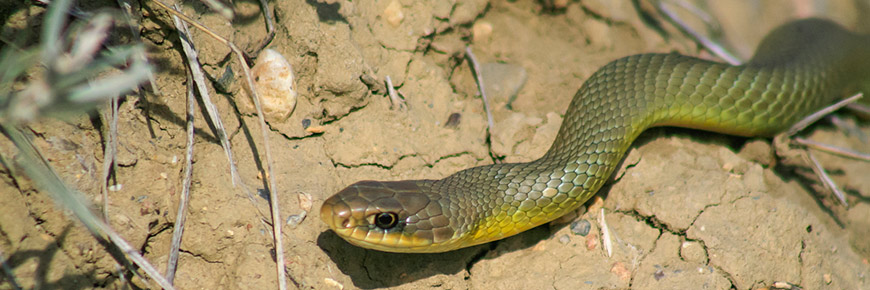- Scientific name: Coluber constrictor flaviventris
- SARA Status: Threatened
- COSEWIC Status: Threatened
- COSEWIC Range: Alberta, Saskatchewan
As their name suggests, Eastern Yellow-bellied Racers are the fastest snake in Canada. They are also good climbers that are often spotted basking in shrubs. These snakes are non-venomous and harmless to humans.
Eastern Yellow-bellied Racers are long, slender snakes that can be identified by their green backs and yellow/cream underside. These colors allow them to travel at high speeds while remaining camouflaged in the grass and dirt. Their diet consists of mostly insects, such as grasshoppers, as well as other small animals like rodents, birds, and frogs, all of which can be found in their preferred habitat of open grasslands and mixed-grass prairies.
The distribution of Eastern Yellow-bellied Racers stretches across the central United States, with southern Alberta and Saskatchewan at the most northern extent of their global range. With such restricted range within the two provinces, the conservation value of this species is high in Canada.
For the populations that over-winter in Canada, they have special adaptations needed to survive freezing temperatures. This involves hibernating in communal or non-communal hibernacula that are deep enough in the ground and often situated on south-facing slopes.
Like many other grassland species, the Eastern Yellow-bellied Racer uses abandoned rodent burrows for nests and hibernation sites, as well as rotting wood, stumps, and areas beneath flat rocks. However, the species is limited by their ability to find hibernation sites before winter begins.
Threats: Eastern Yellow-bellied Racers are heavily affected by habitat loss because they have specific needs for nesting, hibernating, and summer foraging. As grassland conversion takes place, the likelihood of finding suitable habitat for these ecological functions decrease.
Racers are also impacted by human activity in their habitat and are often killed by farm equipment when in farmers’ fields looking for insects, as well as being run over by cars when they are crossing roads or basking in the sun. Furthermore, much of their prey population, such as grasshoppers, are being reduced by pesticides.
What’s being done: Eastern Yellow-bellied Racers are protected federally under the Species At Risk Act (SARA) and under The Saskatchewan Wildlife Act. There is no legal protection for racers in Alberta since there is no verified record of them being observed. To address this, there needs to be formal surveys completed in order to confirm their presence. There have been strategies developed at Grasslands National Park to minimize road mortality. Parks Canada has also been monitoring and researching hibernacula over time to inform management decisions and conservation efforts.
Resources:
Species at Risk Profile Series: Eastern Yellow-bellied Racer

